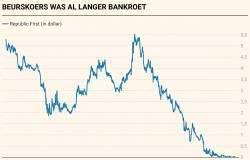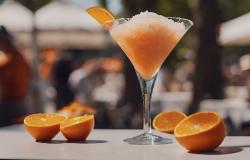Kailey Miller and her research project abstract. Photos by Darrell J. Pehr
Fall mowing height influence on annual bluegrass putting green spring recovery
Annual bluegrass (Poa annua) golf course putting greens are prone to winterkill in northern regions. Previous investigations indicate a decline in annual bluegrass crown carbohydrate contents during dormancy and winter stresses like ice encasement. The objectives of this field and growth-chamber study were to evaluate whether increasing the mowing heights in September promote higher carbohydrate content and winter recovery.
Field plot moving heights were equivalent during the summer at 0.125 inches (3.175 millimeters). Mowing treatments started in the first week of September in 2021/2022 at 0.125, 0.15, 0.175 and 0.2 inches (3.175, 3.81, 4.445 and 5.08 millimeters) ending in early November 2021/2022. The treatments were incrementally increased every week during fall acclimation. During the fall acclimation of 2021/2022 and spring deacclimation 2022/2023 periods, normalized difference vegetation index (NDVI) was recorded. The 0.4-inch (10.16-millimeter) turfgrass plugs were taken in March 2022/2023 from the field and moved into a growth chamber to undergo a second winter treatment, during which they were under ice encasement in the growth chamber for 0 and 40 days . After the ice encasement period, total nonstorage carbohydrates (TNC) were analyzed.
Fall and spring NDVI values were positively associated with higher moving heights. Ice encasement recovery rates were enhanced by fall moving height increases. TNC was not influenced by moving height but was influenced by duration of ice encasement. Increasing mowing height of annual bluegrass putting greens during fall acclimation may improve annual bluegrass spring recovery and resilience to ice encasement, but further research is needed to understand the mechanism associated with changes in recovery.
— Kailey Miller ([email protected]) and Emily B. Merewitz, Ph.D., Michigan State University
Pingyuan Zhang and his research project abstract.
Hollow-tine cultivation effect on dollar spot in creeping bentgrass
Coring cultivation and top dressing are routine practices on golf courses used to manage thatch, largely by dilution with soil re-incorporation. Our hypothesis was that modifying the thatch and lower canopy to be more soil-like may reduce dollar spot severity. Two cultivation treatments were evaluated at two sites (North Brunswick, NJ, and Storrs, Conn.) on creeping bentgrass managed as fairway turf for effects on the development of dollar spot.
Cultivation treatments included an untreated control (UTC) and hollow-tine cultivation. Soil brought to the surface with hollow-tine cultivation was immediately re-incorporated with brushing. Hollow-tine cultivation was applied during spring when the soil temperature (daily average) at the 1.97-inch (5-centimeter) depth reached 50 F (10 C) for three consecutive days during 2021, 2022 and 2023; fall treatments occurred early-to-mid-October. Six cultivation treatments were applied to date.
Disease severity was measured as the number of dollar spot infection foci per plot every seven to 28 days from the disease onset until August. Clarireedia jacksonii (dollar spot pathogen) inoculum concentration in leaf tissue and the thatch organic matter concentration were measured in 2023 prior to dollar spot symptom development. The suppression of dollar spot development in hollow-tine plots was greater in subsequent years at the Connecticut site, suggesting a cumulative effect likely associated with an increasing modification of the thatch and lower canopy. A significant reduction in disease from hollow-tine treatment at the New Jersey site was only observed during 2022.
Organic matter concentration was significantly diluted in the thatch-mat layer measured in 2023 at both sites, suggesting cultivation treatments modified the surface and canopy properties. The C. jacksonii inoculum concentration measured after the fifth hollow-tine indicated treatment lower pathogen load heading into the third season compared to the UTC in New Jersey and Connecticut, with a greater reduction observed in Connecticut.
— Pingyuan Zhang ([email protected]) and James A. Murphy, Ph.D., Rutgers University, New Brunswick, NJ
Darrell J. Pehr ([email protected]) is GCM’s science editor.







